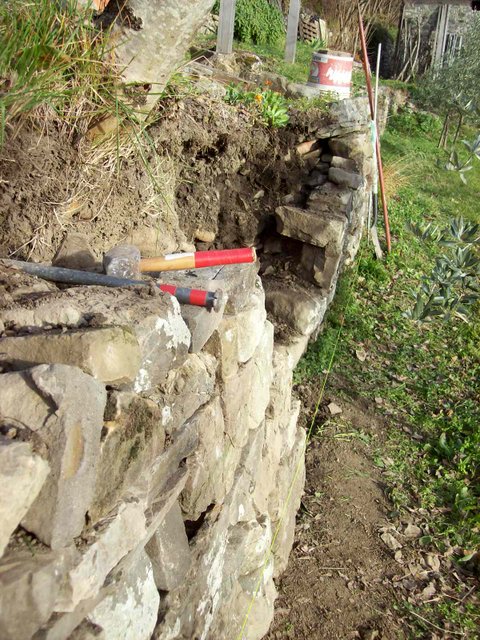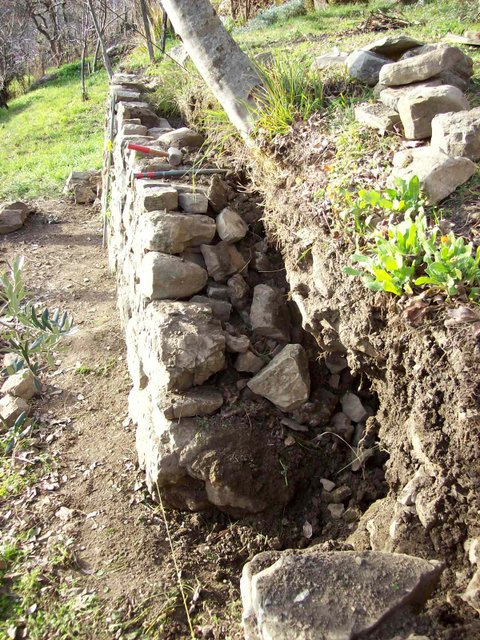Uno Su Due – English Translation Posted by Geoff on Dec 30, 2016 in Italian Language
Here, as promised, is the full English translation of yesterday’s blog Uno Su Due.

In primo piano: un pezzo del muro che ho già rifatto con, appoggiati sopra, la mia mazzetta e il piede di porco. Sullo sfondo si vede il vecchio muro storto e pericolante che è ancora da rifare. Giù in basso si intravvede la linea gialla. In the foreground: a piece of the wall that I’ve already rebuilt, with my mallet and crow bar resting on top. In the background you can see the old deformed, crumbling wall that still needs rebuilding. Down at the bottom you can just see the yellow line.
Stefano: Ciao Geoff! Cosa stai facendo?
Geoff: Ciao Stefano! Sto ricostruendo questo muro a secco pericolante … infatti ne è già crollato un pezzo più di un anno fa, ma finora non ho avuto l’opportunità di metterlo a posto. Ora è il periodo giusto … non è né troppo caldo né troppo freddo e il terreno non è troppo bagnato
Stefano: Hi Geoff! What are you doing?
Geoff: Hi Stefano! I’m rebuilding this crumbling drystone wall … in fact part of it already collapsed more than a year ago, but up until now I haven’t had a chance to sort it out. Now’s the right time … it’s neither too hot nor too cold, and the ground isn’t too wet
Stefano: Io non ho mai fatto un lavoro del genere … non saprei neanche da dove cominciare … ti servono degli attrezzi particolari?
Geoff: Insomma, gli attrezzi che uso sono pochi: una mazzetta, un piede di porco, una vanga, una linea e, ovviamente, dei guanti di cuoio
Stefano: I’ve never done this type of work … I wouldn’t even know where to begin … do you need any specific tools?
Geoff: Well, I only use few tools: a mallet, a crowbar, a spade, a line, and obviously a pair of leather gloves
Stefano: Che cos’è la linea e a cosa serve?
Geoff: E’ questa corda gialla qui … serve a segnare il percorso del muro e a tenerlo il più dritto possibile. Metto due picchetti alle due estremità del tratto di muro che va rifatto e ci attacco la linea, così.
Stefano: What’s the line and what’s it used for?
Geoff: It’s this yellow string here … it’s used to mark where the wall goes and to keep it as straight as possible. I put two stakes at each end of the section of wall that has to be rebuilt and I attach the line to them, like this
Stefano: Allora per rifare un muro cominci col mettere la linea?
Geoff: No, prima ho dovuto organizzare il pezzo di muro crollato
Stefano: So to rebuild a wall you begin by placing the line?
Geoff: No, first I had to organize the bit of fallen wall
Stefano: Cosa intendi per ‘organizzare il muro crollato’?
Geoff: Allora, dov’era crollato il muro c’era rimasto un mucchio di sassi, sassolini e terra … quindi ho dovuto separare il tutto. Bisogna accatastare il materiale in un posto dove poi ti non stia fra i piedi mentre lavori. Quindi, siccome ho intenzione di lavorare verso destra perché è quello il tratto che va rifatto, ho messo i sassi lì a sinistra contro il muro che non va toccato, e mentre c’ero ho separato la roba così: lì sassi buoni, cioè quelli più squadrati; là sassi brutti da usare all’interno del muro
Stefano: What do you mean by ‘organize the fallen wall’?
Geoff: Well, where the wall had collapsed there was a heap of rocks, small stones and soil … therefore I had to separate it all. You have to pile up the material somewhere where it won’t be in your way while you’re working. So, as I intend to work towards the right, because that’s the bit has to be rebuilt, I put the rocks there on the left against the wall which isn’t going to be touched, and while I was at it I separated the stuff like this: over there the good rocks, in other words the more square ones; over there bad stones to use inside the wall
Stefano: Allora è molto importante organizzarsi bene prima di cominciare!
Geoff: Sì, se non ti organizzi bene è un casino! Per esempio provo a stendere i sassi in maniera che posso individuare subito quello giusto quando ne ho bisogno
Stefano: So it’s very important to be well organized before you begin!
Geoff: Yes, if you’re not well organized it’s a mess! For example, I try to spread the rocks out so that I can find the right one straight away when I need it
Stefano: Già, perché non è come costruire un muro in mattoni che sono tutti uguali
Geoff: Esatto, è più come fare un incastro gigantesco in 3D
Stefano: Of course, because it’s not like building a wall with bricks which are all the same
Geoff: Exactly, it’s more like doing a gigantic 3D puzzle
Stefano: Quindi da dove cominci?
Geoff: Ovviamente la base del muro è importantissima. Per quella ci vogliono i sassi più grossi e più squadrati possibili e bisogna piazzarli in maniera molto stabile, che siano o orizzontali o con una pendenza all’indietro, mai verso il davanti
Stefano: So where do you begin?
Geoff: Obviously the base of the wall is very important. For that you need the biggest squarest rocks possible, and you need to place them very stably, so that they are either horizontal or sloping towards the rear, never towards the front
Stefano: Poi ci sono delle regole da seguire?
Geoff: Infatti, come mi hanno insegnato i contadini, la regola di base è sempre ‘uno su due’, proprio come quando fai un muro in mattoni
Stefano: Are there any are rules to follow then?
Geoff: Sure, as the contadini taught me, the basic rule is always ‘one on two’, just like when you build a wall with bricks
Stefano: Immagino che però sia molto più complicato perché ogni sasso è diverso
Geoff: Sì, ecco perché è importante poter vedere tutti i sassi che hai a disposizione per poter scegliere quello giusto
Stefano: I imagine however that it’s far more complicated because every rock is different
Geoff: Yes, that’s why it’s important to be able to see all the rocks that are available, so that you can choose the right one
Stefano: Ma se i sassi sono tutti un po’ storti, come fai a fare una bella facciata così dritta?
Geoff: Allora cosa faccio? Lavoro proprio a partire dalla facciata. Ad esempio, vedi questo sasso qua che c’ha un lato bello dritto? Ora lo metto su questi due sassi e faccio una prova della sua stabilità … se è completamente instabile, cioè si può muovere in tutte le direzioni, lo metto da parte e lo uso altrove. Se invece balla poco, può darsi che lo posso usare, basta che non tenda a cadere in avanti. Se cade all’indietro non importa perché dietro uso i sassolini e in particolare quelli che hanno la forma a cuneo per incastrare per bene il sasso in maniera che non si muova più
Stefano: But if the stones are all a bit deformed, how do you manage to make a nice straight face?
Geoff: Well, here’s what I do, I actually work from the face. For example, see this rock here that has one side nice and straight? Now I’ll put it on these two stones to test how stable it is … if it’s completely unstable, that is if it moves in all directions, I put it aside and use it somewhere else. If on the other hand it only wobbles a bit, I could use it as long as it doesn’t tend to fall forwards. If it falls backwards it doesn’t matter, because I put small stones behind, especially the wedge shaped ones, to completely block the stone in so that it doesn’t move anymore

Nella foto si vede come ho usato la facciata più bella dei sassi per il davanti del muro mentre dietro li ho stabilizzati con gli ‘scarti’. In the photo you can see how I’ve used the nicest stones for the front of the wall while stabilising them from behind with the ‘leftovers’.
Stefano: Quindi tutti quei sassolini che hai messo da parte …
Geoff: Quelli li uso sia come zeppe come ho già detto sia per riempire lo spazio fra la facciata del muro e il terreno dietro
Stefano: So all those little stones you put on one side …
Geoff: I use those both as wedges, as I said, and also to fill in the space between the face of the wall and the ground behind
Stefano: Allora non si costruisce il muro direttamente contro il terreno?
Geoff: Esatto, il muro è costituito dalla facciata, fatta con i sassi più belli e più stabili, e da uno strato posteriore fatto di sassolini e sassi irregolari. Dietro infine c’è il terreno. In questo modo usi tutto
Stefano: So you don’t build the wall directly against the land?
Geoff: Exactly, the wall is made up of the facade, built with the nicest and most stable rocks, and a back layer made up of small stones and irregular rocks
Stefano: Immagino che quello strato di sassolini aiuti anche con il drenaggio
Geoff: Esatto, così quando piove forte l’acqua non viene bloccata dietro il muro, ma ‘traspira’, per così dire.
Stefano: I immagine that the layer of little stones also helps with the drainage
Geoff: Exactly, so when it rains hard the water doesn’t get blocked behind the wall, but ‘perspires’, you might say.
Stefano: Sta’ a sentire, adesso devo andare. Mi metti una foto su facebook quando l’hai finito?
Geoff: Come no! Ciao, a dopo …
Stefano: Listen, I’ve got to go now. Will you put a photo on facebook for me when you’ve finished it?
Geoff: Of course! Bye, see you later …

Build vocabulary, practice pronunciation, and more with Transparent Language Online. Available anytime, anywhere, on any device.




Comments:
Alexandra:
This was a great exercise. Not having the translation yesterday forced me to work harder and I appreciate that. Thank you!
Geoff:
@Alexandra Thanks for the feedback Alexandra. I’m glad the format worked for you. I think that having the translation available straight away can sometimes make us a bit lazy. So the fact that you tell me that this format made you work a bit harder is really useful.
A presto, Geoff 🙂
jaclyn:
Grazie mille! I thoroughly enjoyed reading this and learning from it. More, please.
paolo minotto:
Grazie mille. Ho imparato tanto di come costruire un muro a secco.
Buon anno nuovo a te e Serena.
Geoff:
@paolo minotto Buon Anno anche a te da parte nostra Paolo! 🙂
Jo Sheldon:
Inspirational! I just can’t wait to get started. Very erudite explanation, my son.
Geoff:
@Jo Sheldon Do send me some photos of your stone wall when you’ve finished building it mother. Love from your son, Geoff 😉
Jerry:
Well done Geoff! I think your explanation makes very good sense. Which is only natural, right? After all, we all know that Italians are one of the original pioneers of masonry! I agree with Alexandra, although not so easy, the “extra work” should pay off.
Happy New Year to you and Serena
Geoff:
@Jerry Grazie mille Jerry. Buon anno! 🙂
John:
Grazie mille Geoff. Mi è piaciuto imparare le parole italiane per gli strumenti, per esempio piede di porco é un “crow bar” in inglese!!! Buon lavoro.
Geoff:
@John Non so perché si chiama ‘crow bar’ in inglese. Piede di porco è, magari, più logico perché descrive la forma del ‘piede’ dell’attrezzo.
(n.b. di solito parliamo di ‘attrezzi’ per il lavoro di muratore, falegname ecc. Strumenti si usa per cose più delicate, tipo strumenti scientifici, elettronici, chirurgici e così via).
A presto, buon anno da Geoff 🙂